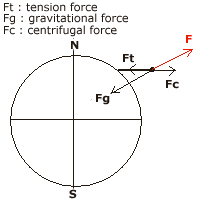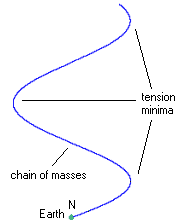
Generating Non-equatorial Towers
The method used to generate non-equatorial towers is to begin with a mass attached to the surface of the Earth by a massless cable. Knowing the free, untensed length of the cable, and the actual distance between mass and tether point, and the spring constant of the cable, the cable tension Ft can be calculated. In addition, the gravitational force acting on the mass, Fg, acting towards the centre of the Earth, can also be calculated. And further, the centrifugal force, Fc acting at right angles to the Earth's axis of rotation can also be calculated.
 These 3 forces may be summed to produce a net resultant force in some direction. Therefore the force F required to counter these forces, and maintain the mass motionless, is this resultant force acting in the opposite direction to the resultant.
These 3 forces may be summed to produce a net resultant force in some direction. Therefore the force F required to counter these forces, and maintain the mass motionless, is this resultant force acting in the opposite direction to the resultant.
Knowing the force F, and the free cable length, it is then possible to work out the position of the next mass further out. And given this, it becomes possible to calculate gravitational and centrifugal forces acting on this mass, and the resultant force, and the inverse force required to keep this mass in place, and hence the position of the next mass. And so on, indefinitely.
 Beginning with some arbitrary position of tether point and mass connected to that tether point, the locations of a series of connected masses can be found. These usually generate surprising swirling arcs outward into space. Examination of these towers shows that they tend to perform the tightest arcs where tension is lowest. And the tension and location of these tension minima is strongly determined by the initial conditions set at the tether point.
Beginning with some arbitrary position of tether point and mass connected to that tether point, the locations of a series of connected masses can be found. These usually generate surprising swirling arcs outward into space. Examination of these towers shows that they tend to perform the tightest arcs where tension is lowest. And the tension and location of these tension minima is strongly determined by the initial conditions set at the tether point.
The iterative technique employed to generate a stable tower is to make small changes in the initial conditions, and always select conditions which reduce the first tension minimum along the chain of masses. When the first tension minimum approaches zero,  the tower is usually found to be angled towards the equator, with its outer length lying almost exactly on the equator. The chain of masses beyond its zero-tension point falls back towards the Earth.
the tower is usually found to be angled towards the equator, with its outer length lying almost exactly on the equator. The chain of masses beyond its zero-tension point falls back towards the Earth.
These are static towers, not siphons. It is not clear whether non-equatorial siphons can function. The results are broadly in agreement with the paper Non-Equatorial Uniform-Stress Space Elevators by Blaise Gassend, in which non-equatorial towers are generated numerically.
The following (highly unpolished) Java applet demonstrates the iterative process, modified base tether tension T and elevation E. Start by moving cursor over applet, then moving it off.
